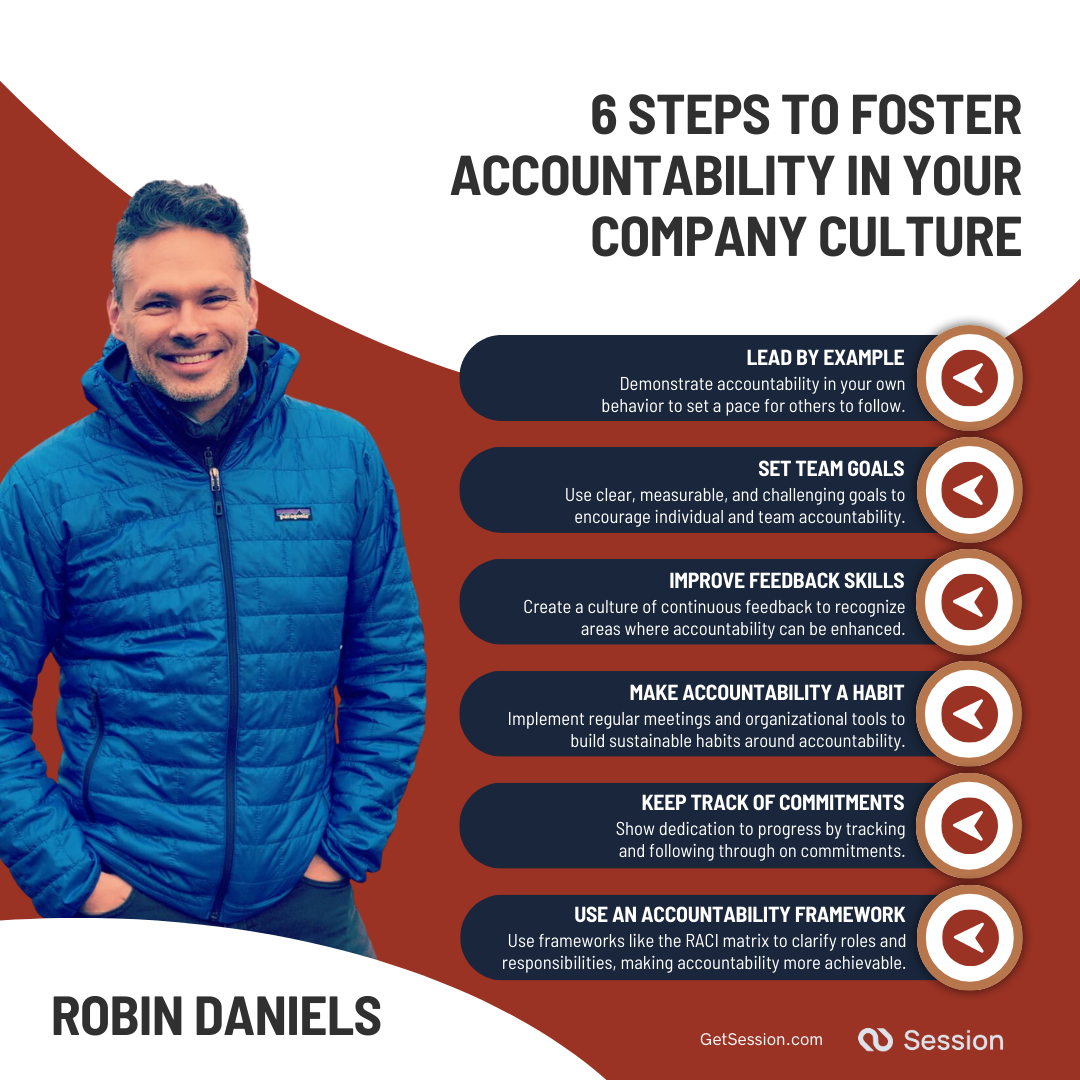Recently, I’ve noticed that accountability has become somewhat of a management buzzword. Personally, I think that accountability is far more than corporate vernacular or a trendy topic to discuss on LinkedIn. Accountability is at the heart of organizational success and high-performing teams: and organizations simply can’t function or perform without it!
It’s about people taking responsibility for their own actions. And it’s about taking initiative and recognizing the power of the individual to remedy problems and find solutions.
Although individual employees must cultivate a sense of accountability in themselves, this does not happen in a vacuum. An organization that cultivates a culture of accountability is likely to also foster accountable individuals. But, accountability doesn’t happen accidentally: it requires strategic steps. In this article, I will dive into what accountability looks like at work, why it’s essential, and how to embed it into your culture.

What Does Accountability Mean In The Workplace?
Accountability in the workplace means that all employees are responsible for their actions, behaviors, performance and decisions. When done right, accountability is linked to an increase in commitment to work and employee morale, which leads to higher performance. It happens when employees feel like they belong to something bigger than themselves - and recognize that their role - no matter how ‘’big’’ or ‘’small’’ plays an important part in the ecosystem of the organization.
Although accountability sounds wonderful in theory, it is not always so easy to implement! If you are frustrated by a lack of accountability in your workplace, you are not alone. Data shows that 82% of managers acknowledge they have “limited to no” ability to hold others accountable successfully, and 91% of employees would say that it’s one of their company’s top leadership-development needs. Low accountability also leads to mistrust, low morale, and a toxic office culture - a combination which is every organization’s worst nightmare.
Next, let’s look at taking some practical steps you can take to embed a culture of accountability within your organization.
Soft Accountability Versus Hard Accountability: What’s The Difference?
Throughout my career, I’ve found that leading teams is what gives me the most joy. To me, leadership is about unifying the best people to do the best work of their lives - that’s what motivates me. I have used both hard and soft accountability measures to enhance my teams’ performance. Let’s take a look at the two:
- Hard accountability: this happens when you set hard goals, and you want people to meet those goals. This manifests itself in targets, growth numbers, and so on. Often, numbers don’t lie! Metrics such as OKRs can be used to set hard accountability goals. OKRs are particularly effective for holding individuals accountable, especially on a quarterly basis. Yet, OKRs don’t necessarily give inspiration for long-term strategy and planning. For this, a framework such as Salesforce’s V2MOM (Vision, Values, Methods, Obstacles, and Measures) model can be highly effective to drive behaviors in the long-term. The combination of the two are extremely strong methods for accountability.
- Soft accountability: this is about setting up a culture of engagement, where people want to go above and beyond for the organization, and for their team. A poor or toxic company culture rarely generates accountability. This is because people who are generally happy to come to work each day, like and respect their colleagues and leaders, and are aligned with the organization’s values - are far more likely to be accountable individuals. From an individual perspective, soft accountability is about nurturing professional relationships, improving upon communication skills, and being a likable, trustworthy colleague that other people want to work with.
Now that I’ve defined both soft and hard accountability, let’s look at the ways in which they can help you get promoted.
Looking to Get Promoted? Here’s Why You Need Both Soft and Hard Accountability To Make It Happen
Just like most things in life, striking a balance is key! And accountability is no different. It’s necessary to have a balance between soft and hard accountability. Let’s break these two down in terms of getting promoted:
Hard accountability: When it comes to getting a promotion, my mantra is: ‘’you can’t just meet your goals, you have to crush your goals’’. To do so, you need to be acutely aware of what those goals are - on a daily, monthly, quarterly, and yearly basis. This is not just a one off event, you typically have to consistently crush your goals to progress to a promotion. Hard accountability comes to the fore here, because you have to fully concentrate on metrics - whether this be OKRs, KPIs, or any other targets that your organization has set.
Soft accountability: When seeking a promotion, your mindset is just as important as your output. My mantra is: ‘’you have to operate like you’re already at the next level.’’ For example, if you’re a senior manager who wants to get promoted to a director, you have to operate like one - well before the promotion takes place. Leaders generally notice when people are stepping up - and these observations will help when it comes to getting promoted. Secondly, you have to combine this with good working relationships. Most importantly, have to have a group of supporters in the company who are singing your praises. I’ve never seen anyone get promoted without this. You could be a rockstar at your job, but if people think you’re unpleasant to work with, it will easily sink your career. Striking the balance between doing the best at your job and treating your colleagues with respect and kindness is what you need to aim for.
Increasing Accountability for Teams: My Three Step Process
When I come into a company to lead a team, there are three phases that I generally implement in order to make accountability happen:
- Unify the team: gather everyone with a strong collective goal in mind and outline the steps that you will take to achieve success. Outline the ways in which you and your team will hold yourself accountable and the steps you will take to do so.
- Optimize the team: now that the team knows what they're going to do, and everyone agrees, you optimize who’s going to do what. Here, you make each person’s roles and responsibilities very clear and align them with their strengths. This is also where you figure out what gaps you might have in skills or resources to achieve your goals, and your budget requirements to achieve them.
- Execution: once you have all agreed on what needs to be done, it’s time to do the work. Ensure that each team member is clear about what needs to be done - as well as the steps that need to be taken in order to execute the job optimally. Then report back weekly, monthly or quarterly, depending on what the project is, to ensure it’s on track.
How to Best Deal With Employee Behavior for Accountability
Unfortunately, accountability is not a black-and-white metric that you can easily integrate within your organization. Its success largely depends on how willing the individual is to implement behavioral change to become more accountable. And because, as individuals, we are all vastly different - it can be a challenge to account for various behaviors and personalities. To simplify these many differences, I have broken it down into four categories of employees:
- The rockstars: these are the types of people you want on your team! Regardless of what job you give them, you just know they’re going to crush it. For these kinds of people, upping their accountability is an easy task. If you have some constructive feedback you would like to share with them, the rockstars are happy to implement it into their work. Generally, rockstars thrive at both soft and hard accountability skills: they crush their hard targets, and also have the people skills to get along well with the team and form positive working relationships.
- The underperformers: quarter after quarter these people are underperforming. Here, you owe it to the team to exit them out - as they don’t inspire anyone and may negatively affect other’s performance and accountability. This is because they may lower the standard, creating a culture in which people may think they can ‘’just get by’’ without doing much good work. For bigger organizations in which Learning and Development opportunities exist, it may be wise to set them up to undergo some additional training. However, if you’ve given them plenty of opportunities but they are still underperforming, an exit strategy will need to be addressed.
- The toxic people: these people are often very good at their jobs but extremely difficult to deal with. They don’t inspire collaboration or comradery, and generally people do not want to work with them. They can completely derail a culture if their behavior gets out of hand. Simply think of the ‘’rotten apple’’ theory - which tells us that, in every organization, there’s a worker whose attitude or personality can negatively “infect” the rest of their employees through their behavior. Two University of Washington researchers reported that these “bad apples” are like a virus to their teams, and can upset or spoil the whole apple cart. We give the name of rotten apples to co-workers who employ negativity, criticism, or constant abuse. With their behavior, they contaminate the entire workplace, causing stress, suffering, and low productivity. For the sake of the team, the organization, and the culture - it’s important to let go of these people fairly quickly, and you will need the help of a solid HR personnel to do so fairly and effectively.
- The super-nice-but-okay people: these are the people who get along well with everyone, are super nice to work with, but their work is simply just average. You know that there are better qualified people out there who can do a better job than them, but it’s difficult to get rid of them because they are such nice people and you know that if they are gone you will see a disruption in your projects until that role is filled again. Here you have two options (1) coach them to become better and to level up their accountability (2) move them out of the organization.
Although you can alternatively offer them improvement plans, in my experience, this can actually be a long and sometimes cruel process that draws out for too long. Sometimes it can work out, and I’ve seen that happen, but it’s rare once it gets to this point. There’s a home for everyone, and typically the culture and company may not be serving these people either, so it can actually turn out to be a service to them in the long-run as well. In my experience, they always end up finding a better home, even if the process to get there sucks.
How To Make Accountability A Core Part Of Your Company Culture
Now that I’ve discussed how accountability can positively impact teams’ and individual’s performance, as well as increasing the likelihood of promotion, I will next discuss some steps on how to make accountability a core part of the overall company culture.
1. Lead by example: be a good apple!
Whether you work within your organization’s HR department, or you are a manager with direct reports, your performance and attitude influences your organization - and employees will follow your lead. Leaders who are diligent, stick to their word, don’t push deadlines, and own up to their mistakes - are accountable leaders. They can set a pace for others to follow which becomes infectious.
The test:
Examine your behavior as a leader in the workplace. When was the last time that you acted without accountability? Perhaps you blamed your mistake on someone else, missed a deadline and did not own up to it, or promised a colleague something that you didn’t follow through with. Although nobody is perfect - and nobody can achieve 100% accountability at all times, it’s still important to strive to be as accountable as you can.
2. Set team goals
As I mentioned in the hard accountability section, creating a culture of accountability on your team requires methodical goal setting. Employees will have a difficult time in holding themselves accountable if they do not know which purpose their goals serve - that’s where an OKR framework (objective and key results) comes into play. To set goals that encourage accountability, they need to be measurable, clear and challenging. OKRs are exactly this - they are created together as a team so that everyone is included. This makes it easier for everyone to understand their roles and what’s expected on both an individual and team level.
The test:
Examine your organization’s OKRs, KPI’s or other measurement systems. Do they encourage accountability at both an individual and team level? Are they transparent? If you answered no to this, what steps will you take to implement improvements to your organization’s accountability metrics?
3. Improve upon your feedback skills
Giving feedback isn’t easy, but it’s a skill that can be improved. And it’s one of the most important things you do as a leader. Humans are creatures of habit, so without feedback, ourselves and our employees will continue doing what we always did, not recognizing that it might no longer add value. Without feedback - accountability simply cannot succeed - because without it, we cannot recognize the areas in which we lack accountability. Instead of sporadically providing feedback to employees, it’s necessary to create a culture of continuous feedback,which provides employees with an opportunity to grow personally and professionally, creates engagement and stronger performance, and improves business results. As a leader, the feedback you give needs to ideally be as close to real time as possible. This gives you the opportunity to coach and offer areas of improvement to the employee, too. And it can also be integrated into quarterly feedback via summary.
The test:
Reflect upon your feedback style. Do you avoid giving regular feedback, for fear of insulting employees or causing tension? When you do give feedback, how do you implement accountability factors into it?
4. Make accountability a habit
It’s not enough to just talk about accountability - as a leader, you need to implement actionable steps to ensure that accountability is woven into the fabric of your organization. Keeping regular meeting agendas with designated tasks roles is a great way to ensure that each employee is accountable for their workload. You can also avail of great organizational tools such as Monday.com, Asana, or Click-Up, which serve to keep everyone accountable. One-on-ones and team meetings also serve as fantastic opportunities to build sustainable habits around accountability.
The test:
Think about the practical ways in which you hold your team accountable. Do you use organizational tools to delegate tasks? Do you regularly attend one-on-ones and check-ins to ensure that each employee is getting their work done and being accountable for it? If not, what are the steps you can take to ensure this happens?
5. Keep track of your commitments
If you make a promise to provide more feedback to your direct reports, make sure you add that as a future agenda item to hold yourself accountable. Or, if your employee commits to providing a work back schedule for a project by a certain date, make sure you have a way to check-in on that day. Accountability goes both ways - so as a leader, you need to let your employees know that they matter to you - and thus show that you’re accountable when it comes to their individual growth. Tracking your commitments lets employees know that you're dedicated to their progress and shows that you lead by example when it comes to accountability - this is accountable leadership.
The test:
Think about the last time you provided feedback. Did you follow up with the individual/team to implement actionable steps for improvement? If not, what can you do to ensure this happens in future meetings?
6. Use an accountability framework
A lack of accountability is rarely intentional. Often, it’s a result of other problems — one being unclear roles and responsibilities. When there’s a lack of clarity around who’s responsible for what, it makes accountability nearly impossible. In fact, a Gallup study found that only 50% of employees strongly indicate that they know what’s expected of them at work.
Luckily, accountability frameworks like the RACI matrix can help with this problem. This accountability framework ensures everyone involved with a project is assigned a role every step of the way. These roles are broken out into 4 levels of accountability:
- Responsible: Those who are responsible for completing the task at hand.
- Accountable: Those who are ultimately accountable for the completion of the task or deliverable. This individual is also responsible for delegating the work to those who are responsible for completing it.
- Consulted: These individuals are typically the subject-matter experts on the task at hand. They are involved in the specific stage of the project in a consulting and advisory capacity.
- Informed: These are the individuals who are kept up-to-date on progress at each stage of the project. This is usually done in the form of one-way communication.
The test:
If you haven’t already done so, try testing out an accountability framework such as the RACI matrix. After testing it, reflect on how the level of accountability within your organization has improved.
Conclusion
I hope you have enjoyed reading this article and that it will help you to improve your own accountability as well as your organization’s. Remember, to create a culture of accountability - you need to be a role model. That means full transparency, ownership of your responsibilities, and the ability to recognize, support, and reward employees who have assumed full responsibility over their work. Also remember to implement feedback on a regular basis - which is inextricably linked to creating a culture of accountability. The power of accountability is a force to be reckoned with: it can optimize employee ownership, increase productivity and motivation, and empower employees to find creative solutions to problems - without placing the blame on others. I hope your journey to creating a culture of accountability is a hugely successful one!












